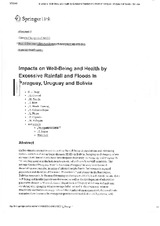Impacts on well-being and health by excessive rainfall and floods in Paraguay, Uruguay and Bolivia

View/
Date
2016-03-25Author
Nagy, GJ
Coronel, G
Pastén, M
Báez, J
Monte-Domecq, R
Galeano-Rojas, A
Flores, L
Ciganda, C
Bidegain, M
Aparicio-Effen, M
Arana, I
Metadata
Show full item recordAbstract
Hydro-climatic anomalies are impacting the well-being of populations and increasing vector-, rodent- and water-borne diseases (H-ID) in Bolivia, Paraguay and Uruguay where extreme ENSO- linked floods have been frequent since 2007. In Paraguay and Uruguay H-ID have increased over the last decade associated with yearly rainfall variability. The extreme floods of Paraguay River in Asuncion (Paraguay) in 2014 were the most devastating ever recorded in terms of affected people due to the increase in exposed population and duration of the event. The extreme flood of 2007 in the Beni region, Bolivian Amazonia, is discussed focusing on the nature of the link with ENSO events. Both well-being and health impacts are discussed as well as the development of adaptation plans after disasters. The evolution of Hepatitis A in Uruguay which was endemic and correlated with droughts where a sewage deficit existed is also discussed because mandatory vaccination strongly reduced the number of cases since 2007. Future climate scenarios show increases in average temperature and modified rainfall patterns, with increases in Uruguay and decreases in Bolivia and Paraguay for 2011-2040. There is high uncertainty with regard to river flow, floods and health impacts, and more hydro-climatic extremes are expected. There evidence of both and adaptation deficit to cope with current climate and a risk-management learning process, the balance of which remains to be established.
